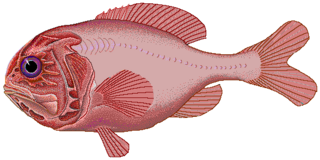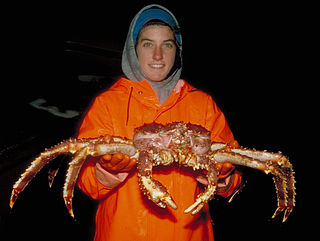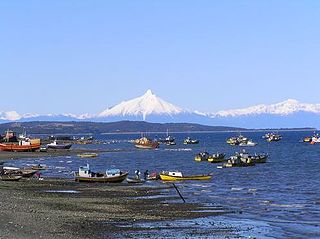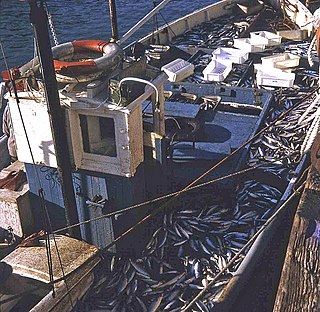Related Research Articles

Halibut is the common name for three flatfish in the genera Hippoglossus and Reinhardtius from the family of right-eye flounders and, in some regions, and less commonly, other species of large flatfish.

Angling is a fishing technique that uses a fish hook attached to a fishing line to tether individual fish in the mouth. The fishing line is usually manipulated via a fishing rod, although rodless techniques such as handlining also exist. Modern angling rods are usually fitted with a fishing reel that functions as a cranking device for storing, retrieving and releasing out the line, although Tenkara fishing and traditional cane pole fishing are two rod-angling methods that do not use any reel. The fish hook itself can be additionally weighted with a denser tackle called a sinker, and is typically dressed with an appetizing bait to attract and entice the fish into swallowing the hook, but sometimes an inedible fake/imitation bait with multiple attached hooks is used instead of a single hook with edible bait. Some type of bite indicator, such as a float, a bell or a quiver tip, is often used to relay underwater status of the hook to the surface and alert the angler of a fish's presence.

Overfishing is the removal of a species of fish from a body of water at a rate greater than that the species can replenish its population naturally, resulting in the species becoming increasingly underpopulated in that area. Overfishing can occur in water bodies of any sizes, such as ponds, wetlands, rivers, lakes or oceans, and can result in resource depletion, reduced biological growth rates and low biomass levels. Sustained overfishing can lead to critical depensation, where the fish population is no longer able to sustain itself. Some forms of overfishing, such as the overfishing of sharks, has led to the upset of entire marine ecosystems. Types of overfishing include: growth overfishing, recruitment overfishing, ecosystem overfishing.

The goal of fisheries management is to produce sustainable biological, environmental and socioeconomic benefits from renewable aquatic resources. Wild fisheries are classified as renewable when the organisms of interest produce an annual biological surplus that with judicious management can be harvested without reducing future productivity. Fishery management employs activities that protect fishery resources so sustainable exploitation is possible, drawing on fisheries science and possibly including the precautionary principle.

The Common Fisheries Policy (CFP) is the fisheries policy of the European Union (EU). It sets quotas for which member states are allowed to catch each type of fish, as well as encouraging the fishing industry by various market interventions. In 2004 it had a budget of €931 million, approximately 0.75% of the EU budget.

The orange roughy, also known as the red roughy, slimehead and deep sea perch, is a relatively large deep-sea fish belonging to the slimehead family (Trachichthyidae). The UK Marine Conservation Society has categorized orange roughy as "vulnerable to exploitation". It is found in 3 to 9 °C, deep waters of the Western Pacific Ocean, eastern Atlantic Ocean, Indo-Pacific, and in the eastern Pacific off Chile. The orange roughy is notable for its extraordinary lifespan, attaining over 200 years. It is important to commercial deep-trawl fisheries. The fish is a bright, brick-red color, fading to a yellowish-orange after death.

The Magnuson–Stevens Fishery Conservation and Management Act (MSFCMA), commonly referred to as the Magnuson–Stevens Act (MSA), is the legislation providing for the management of marine fisheries in U.S. waters. Originally enacted in 1976 to assert control of foreign fisheries that were operating within 200 nautical miles off the U.S. coast, the legislation has since been amended, in 1996 and 2007, to better address the twin problems of overfishing and overcapacity. These ecological and economic problems arose in the domestic fishing industry as it grew to fill the vacuum left by departing foreign fishing fleets.

Alaskan king crab fishing is carried out during the fall in the waters off the coast of Alaska and the Aleutian Islands. The commercial catch is shipped worldwide. Large numbers of king crab are also caught in Russian and international waters.

The fishing industry in Scotland comprises a significant proportion of the United Kingdom fishing industry. A recent inquiry by the Royal Society of Edinburgh found fishing to be of much greater social, economic and cultural importance to Scotland than it is relative to the rest of the UK. Scotland has just 8.4 per cent of the UK population but lands at its ports over 60 per cent of the total catch in the UK.

The environmental impact of fishing includes issues such as the availability of fish, overfishing, fisheries, and fisheries management; as well as the impact of industrial fishing on other elements of the environment, such as bycatch. These issues are part of marine conservation, and are addressed in fisheries science programs. According to a 2019 FAO report, global production of fish, crustaceans, molluscs and other aquatic animals has continued to grow and reached 172.6 million tonnes in 2017, with an increase of 4.1 percent compared with 2016. There is a growing gap between the supply of fish and demand, due in part to world population growth.
Discards are the portion of a catch of fish which is not retained on board during commercial fishing operations and is returned, often dead or dying, to the sea. The practice of discarding is driven by economic and political factors; fish which are discarded are often unmarketable species, individuals which are below minimum landing sizes and catches of species which fishers are not allowed to land, for instance due to quota restrictions. Discards form part of the bycatch of a fishing operation, although bycatch includes marketable species caught unintentionally. Discarding can be highly variable in time and space as a consequence of changing economic, sociological, environmental and biological factors.

Fishing in Chile is a major industry with a total catch of 4,442,877 tons of fish in 2006. As of 2010, Chile has the seventh largest commercial catch in the world. With over 4,000 km of viable coastline, fishing has been a vital resource for small-scale business and family development for hundreds of years. Due to the Humboldt Current, the Chilean Sea is considered among the most productive marine ecosystems in the world as well as the largest upwelling system. Artisanal fishing is practised all over Chile's 6,435 km long coastline and combines industrial techniques with pre-Hispanic traditions. Recreational fishing tourism in southern Chile's rivers has recently gained worldwide fame attracting actors such as Harrison Ford, Michael Douglas, and Kevin Costner.

As with other countries, New Zealand’s 200 nautical miles exclusive economic zone gives its fishing industry special fishing rights. It covers 4.1 million square kilometres. This is the sixth largest zone in the world, and is fourteen times the land area of New Zealand.

Cod fisheries are fisheries for cod. Cod is the common name for fish of the genus Gadus, belonging to the family Gadidae, and this article is confined to three species that belong to this genus: the Atlantic cod, the Pacific cod and the Greenland cod. Although there is a fourth species of the cod genus Gadus, Alaska pollock, it is commonly not called cod and therefore currently not covered here.
The Quota Management System (QMS) is a type of individual fishing quota that is used in New Zealand to manage fish stocks.
Catch share is a fishery management system that allocates a secure privilege to harvest a specific area or percentage of a fishery's total catch to individuals, communities, or associations. Examples of catch shares are individual transferable quota (ITQs), individual fishing quota (IFQs), territorial use rights for fishing (TURFs), limited access privileges (LAPs), sectors, and dedicated access privileges (DAPs).
Sustainable sushi is sushi made from fished or farmed sources that can be maintained or whose future production does not significantly jeopardize the ecosystems from which it is acquired. Concerns over the sustainability of sushi ingredients arise from greater concerns over environmental, economic and social stability, and human health.

The fishing industry in Denmark operates around the coastline, from western Jutland to Bornholm. While the overall contribution of the fisheries sector to the country's economy is only about 0.5 percent, Denmark is ranked fifth in the world in exports of fish and fish products. Approximately 20,000 Danish people are employed in fishing, aquaculture, and related industries.

Fisheries law is an emerging and specialized area of law. Fisheries law is the study and analysis of different fisheries management approaches such as catch shares e.g. Individual Transferable Quotas; TURFs; and others. The study of fisheries law is important in order to craft policy guidelines that maximize sustainability and legal enforcement. This specific legal area is rarely taught at law schools around the world, which leaves a vacuum of advocacy and research. Fisheries law also takes into account international treaties and industry norms in order to analyze fisheries management regulations. In addition, fisheries law includes access to justice for small-scale fisheries and coastal and aboriginal communities and labor issues such as child labor laws, employment law, and family law.

Fish for finance is a possible trade-off that has been considered by both sides in the trade negotiations between the United Kingdom and the European Union (EU) over their future relationship following Brexit in January 2020. The Brexit withdrawal agreement between the two parties called for an agreement on fisheries to be concluded by June 2020, followed by an agreement on financial services at the end of July, deadlines which were both missed. Both were expected to be part of the final EU–UK trade agreement reached by the end of 2020, the end of the Brexit transition period. The final agreement had some broad outlines for a future fishing deal, primarily gradual EU concessions of fishing quota in UK waters, but was largely silent on finance.
References
- 1 2 Costello, Christopher; Gaines, Steven D.; Lynham, John (2008). "ITQ Managed Fisheries List Map" (PDF). Retrieved May 3, 2010.
- 1 2 3 Chu, Cindy (2008). "Thirty years later: the global growth of ITQs and their influence on stock status in marine fisheries". Fish and Fisheries. 10 (2): 217–230. doi:10.1111/j.1467-2979.2008.00313.x.
- ↑ "Catch Share Spotlight No. 15 Scallop General Category IFQ Program" (PDF). 2010. Archived from %7CNOAA Fisheries Services the original on 2010-08-12. Retrieved May 3, 2010.
{{cite web}}: Check|url=value (help) - ↑ Lock, Kelly (Motu Economic and Public Policy Research Trust), Leslie, Stefan (Ministry of Fisheries (New Zealand)) (April 2007). "New Zealand's Quota Management System: A History of the First 20 Years". Motu Working Paper No. 07-02. Social Science Research Network. SSRN 978115.
{{cite journal}}:|author=has generic name (help)CS1 maint: multiple names: authors list (link) - 1 2 "A Rising Tide: Scientists find proof that privatising fishing stocks can avert a disaster". The Economist. September 18, 2008. Retrieved May 3, 2010.
- ↑ Hardin, Garrett (1968). "The tragedy of the commons. The population problem has no technical solution; it requires a fundamental extension in morality". Science. 162 (3859): 1243–1248. Bibcode:1968Sci...162.1243H. doi:10.1126/science.162.3859.1243. PMID 5699198.
- ↑ Warming, Jens (1911). "Om grundrente af fiskegrunde' (On rent of fishing grounds)". Nationalbkonomisk Tidsskrift. 49: 499–505.
- ↑ Gordon, Howard (1954). "The economic theory of a common-property resource: the fishery". Journal of Political Economy. 62 (2): 124–142. doi:10.1086/257497. S2CID 222437331.
- ↑ Scott, Anthony (1955). "The fishery: the objectives of sole ownership". Journal of Political Economy. 63 (2): 116–124. doi:10.1086/257653. S2CID 153791204.
- ↑ Grafton, Quentin; Delvin,Rose (1996). "Paying for pollution: permits and charges". Scandinavian Journal of Economics. 98 (2): 275–288. doi:10.2307/3440859. JSTOR 3440859.
- ↑ Mansfield, Becky (2004). "Neoliberalism in the oceans: rationalization, property rights and the commons question". Geoforum. 35 (3): 313–326. doi:10.1016/j.geoforum.2003.05.002.
- ↑ Mansfield, Becky (2004). "Rules of privatization: contradictions in neoliberal regulation of North Pacific fisheries'". Annals of the Association of American Geographers. 94 (3): 565–584. CiteSeerX 10.1.1.469.4033 . doi:10.1111/j.1467-8306.2004.00414.x. S2CID 18365959.
- ↑ Leitner, Helga; Peck, Jamie; Sheppard Eric (2006). Contesting Neoliberalism. Guildford: Guildford Press.
- ↑ Davis, Anthony; Jentoft, Svein (May 2001). "The challenge and the promise of indigenous peoples' fishing rights—from dependency to agency". Marine Policy . 25 (3): 223–237. doi:10.1016/S0308-597X(01)00014-8.
- ↑ "THE POLLOCK CONSERVATION COOPERATIVE" (PDF). Retrieved May 3, 2010.
- ↑ Kalinin, Nikita; Vershinin, Mark (2020-10-25). "Strategic analysis of the Russian crab quota auction in 2019". Marine Policy. 122: 104266. doi:10.1016/j.marpol.2020.104266. ISSN 0308-597X. S2CID 226354742.
- ↑ "Sharecroppers of the Sea". 9 October 2006.
- ↑ Rights Based Management – European Commission. Retrieved 7 May 2009
- ↑ "Guaranteed fish quotas halt commercial free-for-all". New Scientist.
- ↑ Costello, Christopher; Gaines, Steven D.; Lynham, John (2008). "Can Catch Shares Prevent Fisheries Collapse?". Science. 321 (5896): 1678–81. Bibcode:2008Sci...321.1678C. doi:10.1126/science.1159478. PMID 18801999. S2CID 24879449. Archived from the original on 2016-05-15. Retrieved 2008-11-06.
- ↑ Essington, T.E. (2009). "Catch Shares Improve Consistency, not Health, of Fisheries". Lenfest Ocean Program.
- ↑ Essington, Timothy (2012). "Catch shares, fisheries, and ecological stewardship: a comparative". School of Aquatic and Fishery Sciences.
- ↑ Essington, T.E. (2010). "Ecological indicators display reduced variation in North American catch share fisheries". Proceedings of the National Academy of Sciences. 107 (2): 754–9. Bibcode:2010PNAS..107..754E. doi: 10.1073/pnas.0907252107 . PMC 2818897 . PMID 20080747.
- ↑ Natividad, G. (2016). "Quotas, Productivity, and Prices: The Case of Anchovy Fishing". Journal of Economics & Management Strategy. 25 (1): 220–257. doi:10.1111/jems.12148. S2CID 156036815.
- ↑ "Pacific Halibut-Sablefish IFQ report 2011" (PDF). Archived from the original (PDF) on 2013-03-10. Retrieved 2013-03-20.
- 1 2 Oostdijk, Maartje; Santos, Maria J.; Agnarsson, Sveinn; Woods, Pamela J. (May 2019). "Structure and evolution of cod quota market networks in Iceland over times of financial volatility". Ecological Economics. 159: 279–290. doi:10.1016/j.ecolecon.2019.01.035. S2CID 159381204.
- ↑ Kokorsch, Matthias (June 2018). "Mapping Resilience – Coastal Communities in Iceland".
{{cite journal}}: Cite journal requires|journal=(help) - ↑ Steinsson, Jón. "Uppboð á veiðiheimildum" (PDF).
- ↑ "Eitraður útgerðarauður - Vísir". visir.is. Retrieved 2019-07-07.
- ↑ "Útgerðarmenn geta ekki haldið þjóðinni í gíslingu". Stundin. Retrieved 2019-07-07.
- ↑ "Fullt gjald fyrir afnot fiskimiðanna - Vísir". visir.is. Retrieved 2019-07-07.
- ↑ "16.000 undirskriftir á sólarhring - Viðskiptablaðið". www.vb.is. Retrieved 2019-07-07.
- 1 2 "The Crazy World of the Quota System (somewhat) Explained". The Reykjavik Grapevine. 2007-07-27. Retrieved 2019-07-07.
- ↑ "Quota Auction not advisable | RNH" . Retrieved 2019-07-07.
- ↑ Gissurarson, Hannes H. (2015). The Icelandic Fisheries: Sustainable and Profitable. University of Iceland Press.
- ↑ "Viðreisn vill markaðslausn í sjávarútvegi - Hluti kvóta árlega á markað". Kjarninn (in Icelandic). 2016-07-15. Retrieved 2019-07-07.
- ↑ Hjörleifsson 1984-, Brynjólfur (2014). Baráttan um kvótann. Áhrif hagsmunaaðila og dómstóla á stjórn fiskveiða (Thesis thesis) (in Icelandic).
{{cite thesis}}: CS1 maint: numeric names: authors list (link) - ↑ Sommer, Lauren (December 23, 2010). "West Coast Fishery Moves To Market-Based System". KQED . Retrieved December 23, 2010.
- 1 2 "The Red Snapper IFQ: Some Success and Serious Problems" (PDF).[ permanent dead link ]
- ↑ "Catch Share Leave Fishermen Reeling". 10 September 2020.
- ↑ "Leasing practices in North Pacific fisheries Bering Sea and Aleutian Island crab fisheries". North Pacific Fisheries Management Council Report. 2009.
- ↑ Pinkerton, Evelyn; Danielle N. Edwards (2009). "The elephant in the room: The hidden costs of leasing individual transferable fishing quotas". Marine Policy. 33 (4): 707. doi:10.1016/j.marpol.2009.02.004.
- ↑ Eytho Hrsson, E. (1996). "Coastal communities and ITQ management. The case of Icelandic Fisheries". Sociologia Ruralis. 36.

